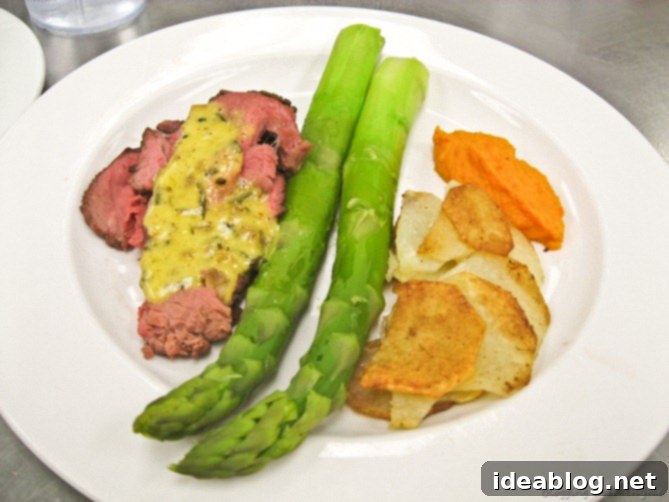Mastering Classic French Cuisine: A Culinary School Menu Day with Roast Beef, Béarnaise, and More
Returning to the bustling kitchen after last week’s intense practical exam, our culinary school journey continued with an exceptionally ambitious menu. As we settled into our classroom, the sheer length of the day’s culinary lineup displayed on the board was initially quite daunting. Fortunately, while the list looked intimidating, the execution proved to be more manageable, though it still demanded a high level of multitasking and precision. Each worktable was responsible for plating ten portions of every dish, which, as you can imagine, quickly transformed our compact workstations into a flurry of activity and a canvas for a significant number of plates.
Our daily kitchen operations typically involve preparing meals not only for our own class but also for the eager Pastry I students and the front-of-house staff. Yesterday, however, brought an added challenge: the Phase II pastry students were also present, significantly increasing the number of hungry mouths we needed to feed. This meant scaling up production, honing our organizational skills, and ensuring every plate met the high standards expected in a professional culinary environment.
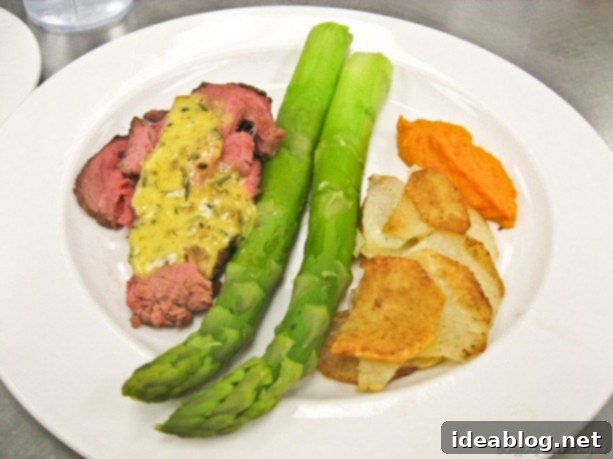
The Star of the Show: Succulent Roast Beef and Classic Béarnaise
The undisputed centerpiece of our menu was the classic roast beef and bearnaise sauce, accompanied by elegant asparagus spears, a vibrant carrot puree, and delicate pomme anna. For those familiar with our previous practical exam, the pomme anna was a sophisticated variation of the potato darphin we meticulously prepared. Our roast beef cut for the day was specifically top butt, a choice that our instructors praised for its exceptional quality. It’s often described as offering “loin qualities at sirloin prices,” which essentially means you get superior tenderness and flavor without the premium cost – truly more bang for your buck in the culinary world! To infuse our beef with profound flavor, we employed a classic larding technique: carefully piercing the sides of the roast and inserting aromatic garlic cloves and fresh rosemary sprigs directly into the meat.
To further enhance both flavor and moisture, we meticulously wrapped the entire roast beef in thin slices of fat back. This pork fat, thinly sliced to just the right consistency, melts beautifully during cooking, basting the meat from the outside in. This simple yet highly effective preparation technique contributes immensely to the richness and succulence of the final dish, ensuring every slice is incredibly moist and flavorful.
Our cooking process began with trussing the meat, a crucial step to ensure it maintained an even shape and cooked uniformly throughout. Following this, the roast was expertly seared on all sides to develop a deep, caramelized crust, locking in juices and adding another layer of flavor. Finally, it was transferred to the oven to finish cooking to a perfect medium-rare. A critical tip for serving this particular cut of meat, as emphasized by Chef Brian, is to cut it in very thin slices against the grain. Failure to do so can result in an extremely tough and chewy texture, leading to his memorable and vivid warning: “Otherwise, you’ll be flossing your teeth with it!” This simple act of slicing correctly can make all the difference in the dining experience.
Vibrant Carrot Puree: A Symphony of Ginger
Complementing the rich beef, our carrot puree was nothing short of delicious, a testament to careful technique and thoughtful flavoring. The carrots were cooked using the traditional étuvée method – gently simmered in a very small amount of water with butter and salt, and covered with a parchment lid. This technique, essentially sweating vegetables in their own juices with minimal liquid, concentrates their natural sweetness and flavor beautifully. For an added layer of aromatic complexity, we incorporated ginger in three distinct ways: crystallized, powdered, and fresh. This multi-faceted approach allowed the ginger’s various nuances – its sweetness from the crystallized form, its pungent warmth from the powdered, and its bright, zesty notes from the fresh – to shine through and create a truly unique flavor profile. Once the carrots were perfectly tender, they were processed into a silky-smooth puree, with a touch more cold butter slowly incorporated at the end to add richness and a luxurious mouthfeel.
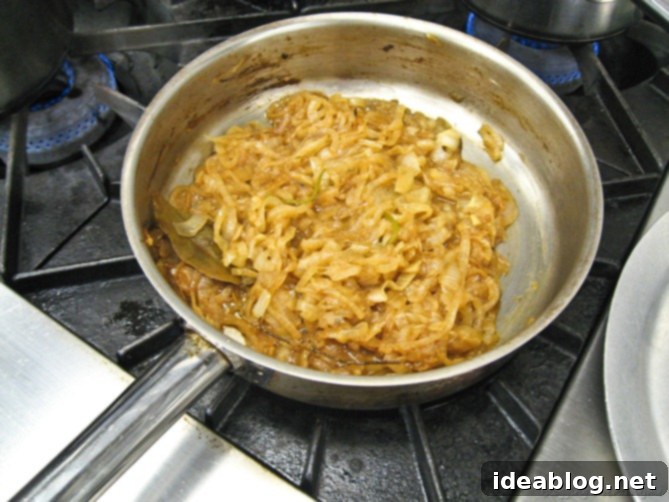
Mastering Béarnaise: A Classic French Reduction
To accompany the robust flavors of the beef, we delved into another hallmark of classic French gastronomy: Béarnaise sauce. This exquisite emulsion is a refined derivative of hollandaise, known for its delicate balance of richness and bright, herbaceous notes. The foundation of Béarnaise begins much like hollandaise, with a stable emulsion of egg yolks and perfectly clarified butter. The real magic, however, lies in the distinctive tarragon reduction that is then whisked into this creamy base. This reduction is crafted by combining crushed black peppercorns for a subtle spice, finely minced shallots for a gentle allium sweetness, a splash of red wine vinegar for acidity, and both dried and fresh tarragon to build a profound herbal character. This mixture is then cooked au sec, meaning “until dry,” which intensifies and concentrates the flavors significantly before being strained and incorporated into the butter and egg yolk base.
I must confess, despite its revered status, I am personally not a great fan of Béarnaise sauce. I often find its richness overwhelming, and I’m increasingly discovering an aversion to the distinct flavor of tarragon. However, I have to admit that the version we prepared yesterday was probably one of the best I have ever tasted, which, coming from me, is quite a compliment! It did pair surprisingly well with the roast beef, creating a harmonious and sophisticated combination. Nonetheless, given the choice, I’d still opt for a rustic pan sauce any day, appreciating its more direct and savory profile.
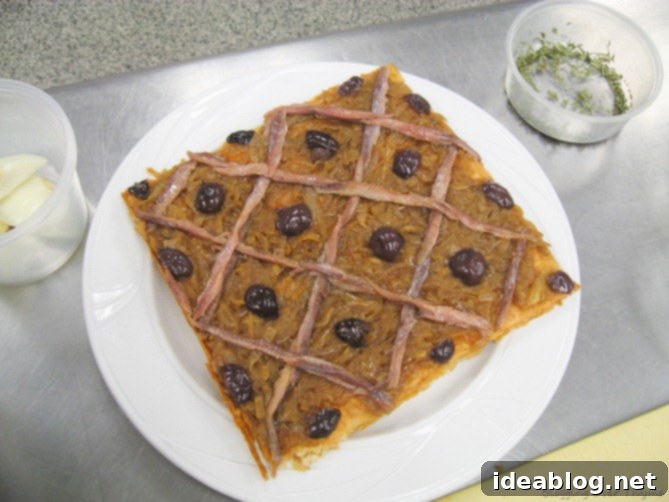
Appetizer Perfection: Savory Pissaladière
For our delectable appetizer, we prepared the traditional French LA PISSALADIERE, a delightful dish originating from Nice (pictured above). This savory tart features a base of crisp, baked puff pastry, generously topped with deeply caramelized onions, creating a sweet and savory foundation. It is then elegantly crosshatched with briny anchovy filets and garnished with flavorful olives, offering a wonderful contrast of textures and tastes. As someone who genuinely enjoys anchovies and olives, I found this dish to be utterly delicious! Beyond its taste, the assembly process was particularly enjoyable, laying out the anchovies in their distinctive pattern and carefully placing each olive to create a visually appealing presentation.
The versatility of Pissaladière is truly inspiring; I can already envision countless possibilities for adding or switching up toppings to create new and exciting variations. From different cheeses to roasted vegetables or even cured meats, the potential for customization is vast, making it a fantastic canvas for culinary creativity in a home kitchen or a professional setting.
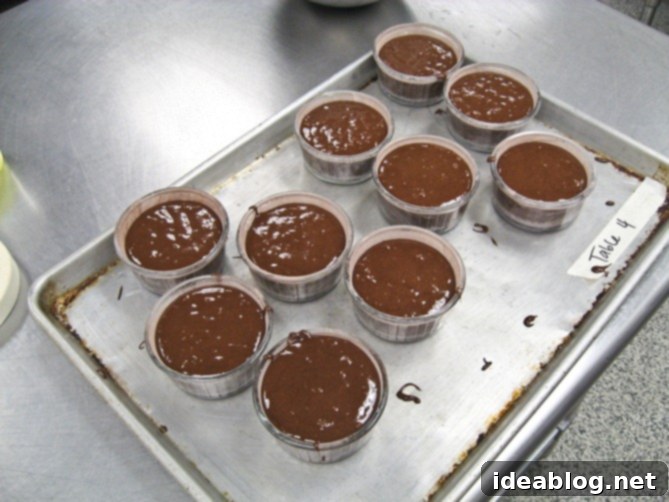
A Sweet Ending: Decadent Molten Lava Cakes
Finally, to conclude our elaborate menu on a high note, we crafted rich and decadent molten lava cakes, known in French as “gâteau au chocolat fondant.” It’s truly difficult to go wrong with these types of desserts; their universally loved combination of a delicate outer cake and a warm, gooey, molten chocolate center is always a crowd-pleaser. As an added bonus for busy kitchens, these delightful individual desserts offer significant convenience: they can be fully assembled as early as the day before they are needed and kept chilled in the refrigerator right up until baking time. This pre-preparation capability greatly simplifies the frantic pace of service, making mise en place incredibly efficient and reducing last-minute stress. While the appearance of the coulis decoration might have been less than perfect – the bottle unfortunately ran dry just as I was finishing – the irresistible molten chocolate interior, served warm with a scoop of vanilla ice cream, ensured that the dessert was an absolute triumph regardless!
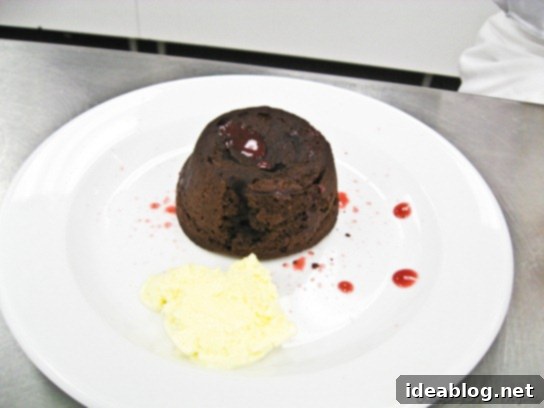
Beyond the Kitchen: A Field Trip to Ayrshire Farms
Looking ahead, tomorrow marks our final day of the week in the classroom kitchen before a highly anticipated change of scenery. On Thursday, our culinary class embarks on an exciting field trip to Ayrshire Farms, a renowned all-organic beef, pork, and poultry farm located in the picturesque Northern Virginia countryside. This excursion promises to be an invaluable learning experience, offering us a first-hand look at sustainable farming practices, animal welfare, and the intricate journey of ingredients from farm to table. Understanding the source of our produce and proteins is becoming increasingly vital in modern culinary arts, and this visit will undoubtedly deepen our appreciation for quality ingredients and responsible sourcing. I’m especially looking forward to this trip and will definitely be bringing my good camera along to capture plenty of photos of the farm, the animals, and the beautiful Virginia landscape. It should be an incredibly fun and educational day!
Be sure to check back tomorrow for another update, where I’ll share all the details and perhaps a few more stories from what promises to be today’s crazy and eventful day in the kitchen!
